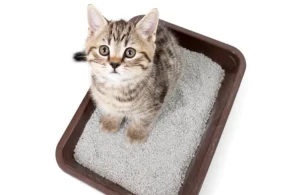My cat keeps sneezing, it turns out he is allergic to cat litter! !

With the increasing variety of cat litter in the market, your cat may develop allergies to some of them. You need to learn how to observe and address cat litter allergies to ensure your cat's well-being.
Since the invention of cat litter by American Edward Lowe in 1947, it has come a long way. Over the decades, various types of clay cat litters have been used. Today, the cat litter industry continues to evolve, with the global cat litter product market expected to reach around $16.538 billion in 2024. It is projected to grow at a compound annual growth rate of 5.40% from 2024 to 2034, bringing forth a dazzling array of cat litter options.
Given the diverse range of cat litter products in the market, it’s not surprising that some may pose health issues or allergies for certain cats. Below, I’ll guide you on how to identify if your cat is allergic to cat litter and suggest ways to improve the situation.
Is my cat really allergic to cat litter?
Healthy adult cats are less prone to cat litter allergies, with the most susceptible groups being kittens, senior cats, and immunocompromised cats (FIV+). Breeds with short noses or flat faces, such as Persian cats, Himalayan cats, and Scottish Fold cats, are also more sensitive to respiratory issues. Cats with other allergies are more likely to develop an allergy to cat litter.
Dust from both the litter and the cat itself can cause sinus or respiratory issues. While humans can wear masks when cleaning the litter, cats cannot. Additionally, it’s essential to remember that a cat’s nose is only 8 inches from the ground, making them closer to the litter box than you are.
While these symptoms can be caused by many different allergens, if you can’t find another cause, cat litter may be the culprit.
Physical symptoms of cat allergies
- Sneezing, coughing, wheezing, tearing, or a runny nose.
- Vomiting or diarrhea.
- Anaphylactic shock (a rare but life-threatening allergic reaction causing sudden facial swelling, restricting airflow, and breathing). In such a case, immediate veterinary attention is necessary.

Behavioral symptoms of cat allergies
- Over-grooming or excessive licking of fur may lead to hair loss or bald patches.
- Behaviors such as chewing, scratching, or biting may accompany licking of fur.
- Scratches around the ears or ear infections are common signs.
- Not using the litter box and relieving themselves outside it.
If you suspect your cat might have an allergy, consider trying a different type of cat litter. If the symptoms persist, it’s crucial to promptly take your cat to the veterinarian. Cat litter allergies can be diagnosed through blood tests or skin tests.

What are the ways to prevent cat litter allergies?
Use cat litter that is less likely to cause allergies in cats
Traditional clay cat litter tends to produce dust, especially when pouring it into the litter box or when the cat is burying its waste. Even cat litters advertised as “dust-free” may not be 100% dust-free in reality.
Cat litters with strong odors can potentially be allergens. Even natural scents from essential oils may not be beneficial for cats. This is not due to the essential oils themselves, but because of their quality. Some manufacturers use essential oils in their cat litter products. However, these oils may not necessarily be of high quality.
The most effective way to address allergies is to eliminate the allergen. Opt for low-dust tofu cat litter, such as premium tofu cat litter, such as food-grade cat litter. These litters are typically composed of natural ingredients like high-quality pea fiber, cornstarch, golden wheat fiber, tea polyphenols, baking soda, and oolong tea powder. These are natural food-grade materials that are friendly to both humans and pets.

Change your cat’s litter box
Some inexpensive cat litter boxes may contain harmful chemicals, such as BPA (Bisphenol A), releasing volatile organic compounds (VOCs), etc. These substances may be released into the environment, causing allergic reactions in cats.
Some cats may have allergic reactions to certain plastics. Therefore, when choosing a cat litter box, it’s advisable to avoid those containing plastics that may cause sensitivity.
To avoid these issues, it is recommended to opt for a high-quality litter box that uses non-toxic materials. Choosing materials labeled as food-grade or specifically designed for sensitive cats helps ensure that the litter box is friendly to the health and comfort of your cat.
Find a spacious, lidless litter box that your cat likes and place it in a ventilated, quiet, low-lying, and easily accessible area.

Clean the cat’s litter box at least weekly
Due to the promises made by many cat litter manufacturers to eliminate odors within ten days, some owners may mistakenly believe that scooping is not necessary every day. However, cat feces is just that—feces. While it can be covered by litter, it won’t magically disappear. Moreover, not all cats enjoy burying their waste. If the litter box is not cleaned regularly, it can become unsightly and unhygienic.
Therefore, regular cleaning of the litter box not only reduces dust and allergens but also helps monitor the cat’s health. Abnormal size, shape, color, or odor of excrement may be signs of health issues. It is crucial to identify and address them promptly.

Clean your cat regularly
How often should you bathe your cat?
This is a question that many cat owners often find themselves pondering. As an experienced cat owner, I have sought advice from several veterinarians. The answers vary—some suggest once a month, others recommend every six months, and there are even those who claim cats never need a bath. With such diverse opinions, it can be a bit perplexing! In reality, cats are incredibly clean creatures. They dedicate a significant amount of time each day to self-grooming, meticulously removing dirt and dust from their fur in a manner that rivals human cleanliness.
Moreover, a cat’s skin naturally secretes oils, forming a protective layer that contributes to the health of their skin and fur. Excessive bathing can strip away these essential oils. This can leave the fur coarse and dull, and potentially lead to skin issues. Therefore, if your cat’s coat appears clean and odor-free, there may be no need for a bath. This is especially true for kittens. Their immune systems are still developing, and excessive bathing could lead to colds or more severe health issues.
Despite a cat’s daily self-cleaning routine, they can’t escape the inevitable “Your mom thinks you’re dirty” judgment! So, how often should you bathe your cat under normal circumstances? Drawing on years of cat parenting experience, I propose two solutions:
Co-Sleeping Scenario: If you share a bed with your cat, a monthly or bi-monthly bath might be reasonable, considering the close daily contact. This approach aims to reduce the risk of shared illnesses between humans and cats.
Separate Sleeping Arrangement: If your cat sleeps in a different room, and your interactions involve more kisses and cuddles than constant contact, you might consider bathing every few months or even once a year.
Irrespective of the bathing frequency, consistent grooming is crucial. It not only aids in minimizing airborne hair but also prevents the formation of hairballs in cats. Utilize a warm towel or disinfectant wipes to cleanse your cat’s fur, ensuring the removal of dust and debris from the toe pads for additional cleaning assistance.

Maintain home hygiene
Keeping your home environment clean is key to preventing your cat from being exposed to harmful substances. These include human leftovers, garbage, and other substances that may cause allergies or illness. Maintaining a tidy space can help prevent your cat from eating inappropriate items. Regularly cleaning living areas, especially floors, furniture, and window sills, can reduce the presence of allergens and keep the air fresh.
At the same time, organize debris, bedding, toys and other items to reduce the impact of debris and dust on cats. Use cat litter mats to prevent cat litter from contaminating other areas of the room. Maintaining household hygiene is vital to your cat’s health and happiness.

When trying to determine the source of cat allergies, you may not have suspected cat litter. But you may find that switching to a different type of cat litter, or taking steps to minimize the dust in the cat litter, can achieve your goal of preventing cat litter allergies.






